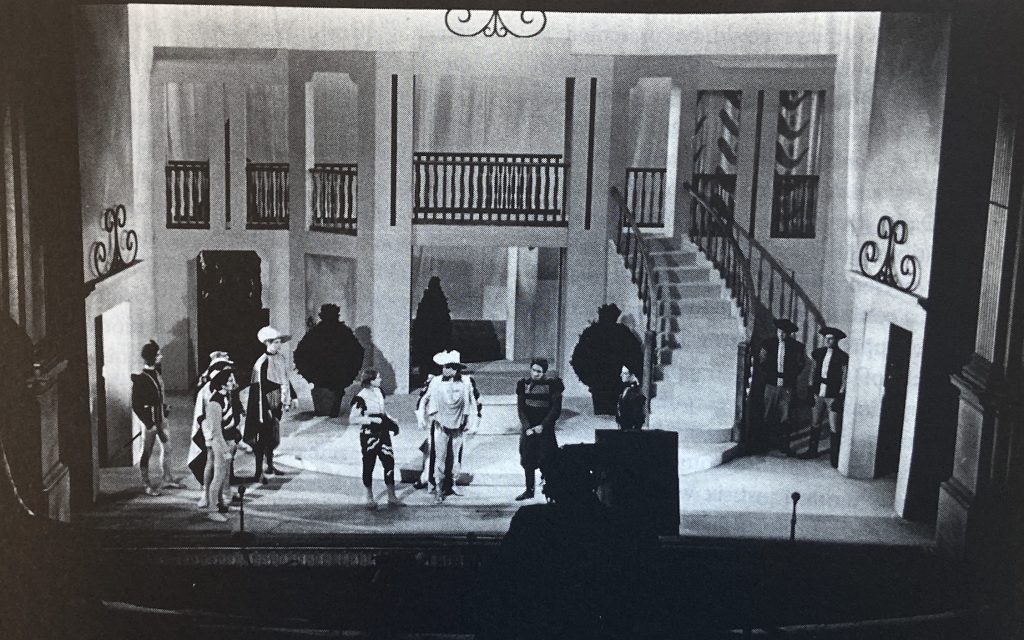OTD in early British television: 2 January 1939

John Wyver writes: ‘ls the ‘straight from the theatre’ stuff going to be satisfactory?’ That was the question Grace Wyndham Goldie posed following the live broadcast of Twelfth Night from the Phoenix Theatre (above) on the evening of 2 January 1939. ‘It is certainly exciting,’ the critic acknowledged. ‘I sat in my own sitting room the other night… [a]nd the miracle of television came home to me afresh. There was the actual feeling of being in a theatre.’ But did you enjoy the play, Ms Goldie? ‘Well, it was rather like being in the theatre and watching the entire action through opera glasses.’
Twelfth Night, with Peggy Ashcroft directed by Michel Saint-Denis, was only the second theatre play presented as an outside broadcast from a West End stage, following the presentation of J.B. Priestley’s When We Are Married the previous November. For details about the production process, see my 2011 Screen Plays blog post here.
Wyndham Goldie’s response to the transmission was equivocal:
The quality of the acting undoubtedly came over. Particularly and notably, I thought, the exquisite rightness of Miss Ashcroft’s ‘Viola’. But the play, seen in camera shots, made very little effect as a whole. How could it? For it was produced for a huge angle of vision, as wide as the theatre’s proscenium arch and it was seen by way of a tiny angle of vision, one no larger than the lens of a television camera.
Other reviewers were more critical. ‘E.H.R.’ in the Observer, who was almost invariably supportive of programmes, wrote that
Twelfth Night proved to be a poor show from the television point of view because it was not produced for the medium. Continuity of action was continually interrrupted by the nedeavours of the cameras to follow rapid movement and the lighting was never really good enough.
The anonymous reviewer for The Times was similarly disenchanted, writing that the play’s
lyric beauty defies the vigilance of mechanical eyes which alter their range minute by minute. The impression given was one of extreme restlessness. Viola was now a tiny figure scarcely distinguishable from half-a- dozen others equally diminutive and now, rather more than life-size, taking up half the screen and hiding the balcony at her back. So with all the others.
The result was to falsify the fluid grace of the production and to tempt all viewers who were not preoccupied with the technical wonders of the apparatus to close their eyes and to treat the affair as broadcast [that is, radio] drama. There was then much to enjoy.
These comments suggest how alien it was for new viewers to make sense of the space of the screen and the movement between shots. Typically, Wyndham Goldie broadened out the argument:
In fact, then, it is becoming perfectly clear that television plays are already of two different kinds and that in showing them television is performing two totally different functions. Television plays shown from the theatre are in the same class as Royal Processions and Test Matches and outside events generally. These are things we could see better if we were actually there ourselves but which it is marvellous to see like this if there is no other way of seeing them.
And this was indeed how television executive came to understand and approach OBs from the theatre, treating them as quite distinct from the separate – and it was thought by many, more creative – forms of studio production. Wyndham Godlie foresaw:
Television studio plays, on the other hand, are adventures in a new medium. They are bound to go on getting belier and better as they leave film on one side and theatre on the other and become more purely television. And they are complete entertainment in the way that the theatre and the cinema are complete entertainment.
So people who care more for ‘going to the theatre’ than for the plays they see and who want to know something of the plays which are running and the actors and actresses who are being discussed will prefer the ‘teleshows’ from theatres. People who Like their plays ‘neat’ will prefer the studio performances.
I would argue that these attitudes have to a large extent continued right down to the present day, leading to the creative contributions of teams that make multi-camera location based screen adaptations being undervalued. But that is an argument to make more fully another day.
Leave a Reply